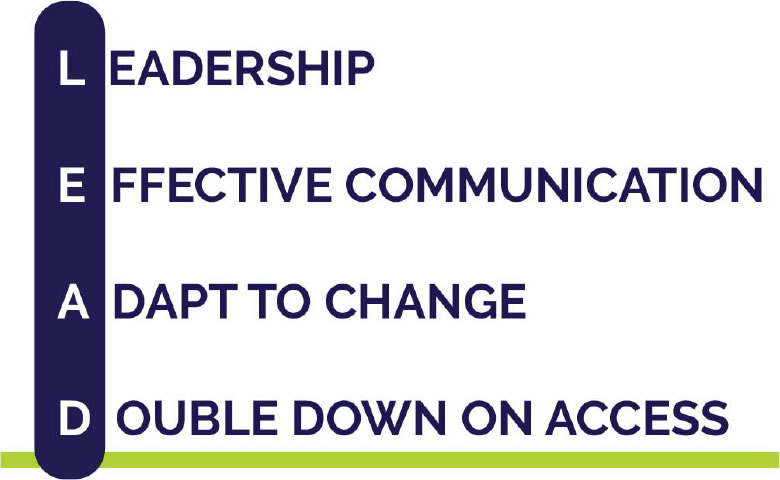The pandemic era has only intensified the need to navigate mental health and substance misuse care efficiently and with dignity.
As an intentional leader, you play a key role in ensuring employees can access effective, timely and affordable care. This includes dismantling mental health stigma, fear of judgement, discrimination, and concern for negative job consequences.
In previous posts we’ve talked a lot about how to raise your own self-awareness and self-care during crisis.
Today’s post, which is the fourth in the LEAD four-part-series, focuses on how to double down on access.

1. Find Out Your Health Plan Benefits
If your company offers a health care plan,step one is to find out what specific mental health benefits it covers, including treatment for substance abuse disorders. Check out this article by EARN (Employer Assistance and Resource Network on how to dig out this valuable information: https://askearn.org/page/pillar-4-ensure-access-to-treatment
2. Share signs of common mental health conditions
Share mental health and well-being resources with employees. This can be done through emails, on Intranets, in newsletters and through other modes of communication.
Share signs of common mental health conditions like anxiety, depression, substance misuse and more.
Encourage employees to NOTICE changes in themselves and/or others, TALK by checking in and letting a person know that you care, and ACT by offering to connect the person with services and supports. You may observe changes in appearance, behavior, mood or thinking. Although everyone is likely experiencing some degree of change during this time, it is still important to check in with one another.
3. Focus on strengthening prevention efforts to manage stress during the pandemic.
The CDC released and linked to resources on this topic (https://www.cdc.gov/coronavirus/2019-ncov/daily-life-coping/managing-stress-anxiety.html)
4. Promote self-care, mindfulness, and coaching.
You may also consider scheduling a virtual meeting with an expert offering self-care and mindfulness sessions so employees can learn how to use these tools on their own. Here is a list of popular self-care apps you can share:
- Moodfit
- MoodMission
- Talkspace
- Happify
- Depression CBT Self-Help Guide
5. Increase employee engagement with your Employee Assistance Program (EAP)
Learn what innovative approaches the EAP is using to connect with employees. Review the mental health services offered through the EAP and consider adding additional options, like well-being coaching sessions, additional counseling sessions, online assessments, and information, 24-hour support, and on-demand crisis intervention.
Consider expanding your EAP and health plan benefits to include free counseling sessions for employees. Ask the EAP to expand the availability of online self-care tools focused on stress management, mindfulness, and resilience training. Ask whether the EAP intends to offer subscriptions to apps designed to address mental health and well-being issues.
6. Train Your Team
Make mental health awareness not just a single talk, but part of your company values. One way to do this is through educating your team. Live workshops, webinars and trainings can help develop your team’s soft skills when relating to colleagues and their mental health needs. You can borrow ideas from The Job Accommodation Network (JAN) instructive video which demonstrates effective tactics for managing an employee with a substance use disorder.
7. Additional Ideas:
Here is an additional list of actions you can take to improve mental health in the workplace(courtesy of EARN at https://askearn.org)
- Provide flexible work arrangements such as flex-scheduling and telecommuting, as well as work-life balance programs.
- Offer fitness programs to improve employees’ physical health, which in turn promotes positive mental health. Include a range of activities from exercises to team sports to informative sessions on the benefits of a healthy lifestyle, including nutrition, ergonomic and fitness advice.
- Involve employees in decision-making and problem-solving processes. For instance, involve them in identifying potential problems that exacerbate stress within the work environment and in proactively implementing solutions to improve working conditions.
- To the extent possible, create a work environment that connects with the outside world through natural light, plants, etc., and provide a versatile, flexible range of spaces. Think about ways to meet employees’ needs for quiet and privacy, as well as spaces that promote positive collaborative work activities.
- Develop and implement anti-bullying policies.
- Sponsor awareness-building and anti-stigma campaigns.
Intentional leadership requires mastery over both your resources and yourself.
Follow me on LinkedIn for more tips on how to advance your leadership skills during uncertain times so your team can thrive.









